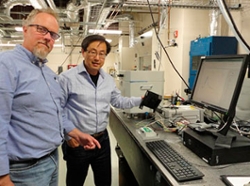Recent News
Not your mother’s nanomedicine: NIH grant targets safer medication for women
October 20, 2025
AI tensor network-based computational framework cracks a 100-year-old physics challenge
September 16, 2025
Postdoctoral research fellow wins 1st place in conference poster presentation
August 25, 2025
Engineering a new treatment for ovarian cancer
June 24, 2025
News Archives
Extending the Life of SolarModules
November 4, 2019 - Tech Bytes: Kevin Robinson-Avila

University of New Mexico and Air Force Research Laboratory scientists have teamed up to prolong the life of solar modules by harnessing the Atom Ant-like strength of carbon nanotubes.
The scientists, Sang M. Han of UNM and David Wilt of AFRL in New Mexico, created a composite material that meshes carbon nanotubes with silver, the standard metal used to conduct electricity in solar cells and modules. They call it MetZilla, or Godzilla-infused metal, which they say could extend the life of solar panels to a minimum of 35 years, and potentially up to 50.
The company previously received a $150,000 Small Business Innovation Research grant from the Air Force, $50,000 in matching funds from the state Economic Development Department, and an undisclosed investment from the Angels.
It’s now doing robust laboratory testing to show how MetZilla-infused solar cells hold up against extreme temperature changes and pressure compared with cells with standard metal conducting lines, said Han, a UNM regents professor in both the Chemical and Biological Engineering and Electrical and Computer Engineering departments.
The goal is to keep electricity moving through the metal lines despite cracks on the solar cells, which tend to pull those lines apart over time. That disrupts electric flow and eventually interrupts it altogether as module degradation leads to open gaps in the lines.
“We introduce cracks into the solar cells and then we push them up and down with a plunger and submit them to thermal (hot and cold) cycling to see how the cracks progress over time with and without the MetZilla paste,” Han said. “We’re at the stage of minimodule qualification, not rooftop-size modules. We want to prove the technology out first at a smaller module scale.”
The tests have shown MetZilla can easily bridge conducting-line gaps caused by cracks in cells of up to 30 microns, and well above 70 microns in some cases, Han said.
Solar cells with standard metal lines generally separate with solar cell cracks of under 5 microns.
The key to MetZilla is the carbon nanotubes fused into the metal paste. The nanotubes are mechanically strong and have good electrical and thermal conductivity, said Wilt, a senior physicist and technical adviser for the Spacecraft Component Technology Branch of the AFRL’s Space Vehicles Directorate.
To read the Business Outlook article, click here
